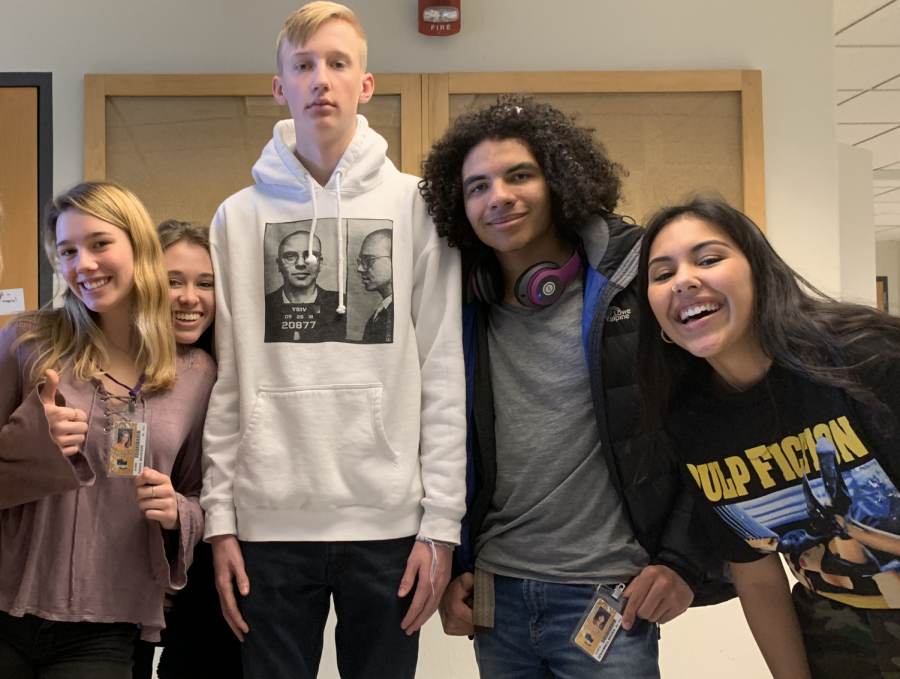The Injustices of Lanyards
Student Identification Policy
Seniors Kenzie Fisher, Anna Fike, River Blessing, Braden Deshommes, and Mikaela Zamora exemplify the varied levels of compliance with the school ID/lanyard policy.
Every BHS student is required to have a current student ID issued at the beginning of the school year. The ID must be visible at all

times and is required for entry into the school on a daily basis, library check-out and to attend school events (i.e. sporting events, dances, etc) at the student rate. Lost IDs may be replaced for $10. Student IDs will allow a student to access the main doors to the building between the hours of 7:30 am and 3:30 pm.
“Do you have a student ID?” Some students would shift their backpacks to reveal lanyards. Some would apologize and rummage frantically through their possessions. Still others would just ignore the questions: since the vast majority students did not wear an ID, punishment was unlikely. At first, it looked like the conflict was going to heat up. During the senior class meeting, students were told that punishments were soon to come. Despite these threats, only 3% of students reported that they wear their student ID regularly on a survey conducted on the BHS Owl’s website. A semester into the year, the tension has died down, attempts at enforcement have petered out, and the lanyards have been forgotten. Or rather, left at home. In fact, the lanyard policy remained on our minds— with unclear punishments and expectations, the lanyard policy has come to represent the power struggle between BHS administration and students. The loser: academic freedom.
From the policy as written in the Boulder High School Student Handbook, we know students are required to wear their lanyards on their person whenever they are on school grounds. What wasn’t made clear, however, is how this rule is enforced. “It’s one of those things for which we haven’t really necessarily looked at what the punishments are,” said Mr. Scott Cawlfield, the school’s Assistant Principal. When we interviewed students, they roughly knew what the lanyard policy required of them, but didn’t have much of an idea of what would happen to them if they didn’t follow it. “If [students] aren’t [wearing their ID] we’re asking them to have it be visible and if it’s an issue where we need to contact someone numerous times we’d maybe reach out to their parents to help get that support,” Cawlfield continued. This lack of clarity makes the rule difficult to enforce, and results in a pattern of on-and-off enforcement. This sporadic enforcement is often unfair.
In legal ethics there is a concept known as selective enforcement. Think of a law that is often broken — for example, the speed limit or any ban on drug or alcohol use. Law enforcement officers are unable to confront every person who breaks the law, so they end up with the discretion to arrest the law-breaker of their choice. Whether their bias is intentional or not, this discretion causes unfair enforcement. In the U.S., selective enforcement of marijuana laws leads blacks to be 3.73 times more likely to be arrested for marijuana and contributes to the blatantly unequal incarceration rates of African Americans (ACLU). Rules that are selectively enforced can be a liability to a fair and diverse community.
Ambiguity around policy enforcement could be a root cause of the low numbers of students who wear their ID card regularly, but another cause seems to be the general lack of information surrounding the policy. BVSD policy puts discipline of such issues under the discretion of the school, and the only publicly available document we could find displaying this policy is crammed on the digital version of the student handbook, which can be found deep within Boulder High’s website. Few of the students we interviewed could pinpoint the reasons why the lanyard policy was put in place.
Student-fabricated reasons ranged from “[the policy] enforces a feeling of paranoia and subconscious fear” to “lanyards enforce the liberal agenda.”
Mr. Cawlfield told us something different: “I think that any time you start something new, regardless of what it is, change is hard. I think for our entire school culture to get to that point where the ideal is that everybody’s wearing it and it’s visible all the time — that’s going to take some time to get there, and we realize that.”
Promoting a culture of ID wearing has certainly proven a challenge for administration. Not only do students neglect to follow the policy, they also have strong feelings about it. Most student interviewees went straight to attacking the policy. “It’s a violation of our basic rights” one argued. Students also addressed why they disliked lanyards so much, citing that it was an inconvenience have to remember to wear their IDs every day. Other student concerns revolved around the fact that school doors are locked during school hours— unlocking these doors requires a student ID card. “If I forget it, I’m locked out. What did I come here to do? Not to… around with my lanyard.”
Several students addressed the idea of gun violence, noting that “a lot of school shootings are committed by students, so having a lanyard isn’t going to prevent a school shooting.” This is a relevant and sensitive issue in the public consciousness, but students aren’t convinced that heightened security policies are relevant or helpful. Many students said new school security made them feel more unsafe. There has to be some new threat from which the school is protecting us, right? No matter what the justification for lanyards is, administration is certainly doing something wrong. Requiring student identification as unpopular as it is impractical. Students dislike the policy and refuse to obey it, doing so in such large numbers that administration is faced with the options of turning their heads or selective enforcement. Boulder High School, a place of learning, a place for everyone has its doors locked all day to those without identification. Thus, the universality of education, the very reason Boulder High was founded is compromised. In the implementation of the lanyard policy, it seems the only real loser is academic freedom.
The lanyard policy has come to reflect changing times—not just at Boulder High but on a national scale. The age of new monitoring and censorship technologies competes with one of weapons more powerful and accessible than ever before— not just weapons that seek blood, but weapons that seek information.
This conflict rages in the shadow of a nation ravaged by political polarization and cultural hypersensitivity. We live in a world of compromises. We must compromise our individuality to agree, we must compromise our anonymity to exist in society, we must compromise our safety to preserve our freedom. To what ends will administration go to keep us safe? How much is this school willing to infringe on our freedom to learn? What will this institution compromise in this world of compromises?








Samantha Black • Nov 14, 2019 at 1:48 pm
I agree with this; we live in such a society of fear now and this does take away one of basic rights.